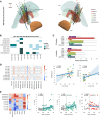Genetic Etiology Influences the Low-Frequency Components of Globus Pallidus Internus Electrophysiology in Dystonia
- PMID: 40062447
- PMCID: PMC11891763
- DOI: 10.1111/ene.70098
Genetic Etiology Influences the Low-Frequency Components of Globus Pallidus Internus Electrophysiology in Dystonia
Abstract
Background: Elevated low-frequency activity (4-12 Hz) within the globus pallidus internus (GPi) has been consistently associated with dystonia. However, the impacts of the genetic etiology of dystonia on low-frequency GPi activity remain unclear; yet it holds importance for adaptive deep brain stimulation (DBS) treatment.
Methods: We compared the properties of GPi electrophysiology acquired from 70 microelectrode recordings (MER) trajectories of DYT-GNAL, DYT-KMT2B, DYT-SGCE, DYT-THAP1, DYT-TOR1A, DYT-VPS16, and idiopathic dystonia (iDYT) patients who underwent GPi-DBS surgery across standard frequency bands.
Results: DYT-SGCE patients exhibited significantly lower alpha band activity (2.97%) compared to iDYT (4.44%, p = 0.006) and DYT-THAP1 (4.51%, p = 0.011). Additionally, theta band power was also significantly reduced in DYT-SGCE (4.42%) compared to iDYT and DYT-THAP1 (7.91% and 7.00%, p < 0.05). Instead, the genetic etiology of dystonia did not affect the spatial characteristics of GPi electrophysiology along MER trajectories.
Conclusion: Considering the genetic etiology of dystonia in closed-loop DBS treatments and utilizing theta and alpha activity for GPi stimulation may optimize clinical outcomes. MER-based DBS lead placement can proceed independently of the underlying genetic cause.
Keywords: alpha oscillations; deep brain stimulation; dystonia; electrophysiology; genetics.
© 2025 The Author(s). European Journal of Neurology published by John Wiley & Sons Ltd on behalf of European Academy of Neurology.
Conflict of interest statement
The authors declare no conflicts of interest.
Figures

References
-
- Kaymak A., Vissani M., Lenge M., et al., “Patterns of Neural Activity and Clinical Outcomes in a Juvenile Huntington's Disease Patient Undergoing Deep Brain Stimulation of the Subthalamic Nucleus,” Deep Brain Stimulation 1 (2023): 15–19, 10.1016/j.jdbs.2023.03.001. - DOI
MeSH terms
Grants and funding
LinkOut - more resources
Full Text Sources
Miscellaneous

